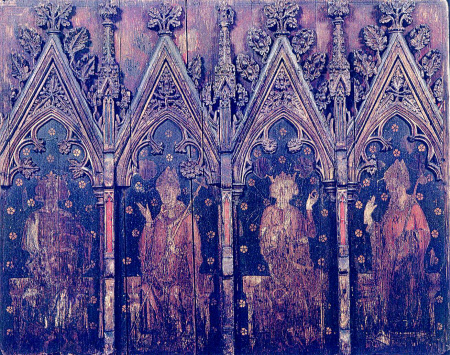Painted screen with St Edmund, an archbishop (possibly Thomas Becket), St Edward the Confessor and a mitred bishop
British (English) School
Category
Art / Oil paintings
Date
1300 - 1315
Materials
Oak with polychrome and gilding
Measurements
845 x 1095 mm
Place of origin
England
Order this imageCollection
Kingston Lacy Estate, Dorset
NT 1257255
Caption
Before the Reformation in religion brought about by the Tudor monarchs Henry VIII, Edward VI and Elizabeth I, England was a Catholic country loyal to Rome. Numerous medieval churches would have had spectacular painted or carved rood screens dividing the nave of the church from the chancel or choir. The painted screen shown here is an English survival from the 1300s and depicts saintly kings and clerics. It was probably an object of devotion and prayer for thousands of Christians over several centuries. The screen is rather damaged, and it is not known how it survived the Reformation or from which church it came. Most religious imagery was destroyed or whitewashed in the 16th century during state-sponsored removals and iconoclastic attacks. The screen appears to have been collected by the Bankes family of Kingston Lacy, Dorset, where it was found in the attic. It remains a remarkable legacy of English religious history.
Summary
Oak with polychrome and gilding, painted screen with St Edmund, an archbishop (possibly Thomas Becket), St Edward the Confessor and a mitred bishop, unidentified maker, English School, 1300-15. A painted oak rood screen depicting four enthroned figures, each enclosed by an arch with foliate carving and Gothic enrichment (finialled and crocketed arches, cinquefoil cusping). From left: St Edmund, seated, facing forwards, identified by an arrowhead; a mitred bishop (possibly Thomas Becket), seated, in three-quarter view, gesturing left to St Edmund, wearing a purple or red chasuble, white gloves and a ring, and identified by his pallium (a vestment reserved for archbishops); St Edward the Confessor, seated, in three-quarter view, holding up his attribute of a ring, gesturing right to the final figure, a mitred bishop wearing a red chasuble. A continuous groove on the reverse confirms that the four panels are an original group, which would have once formed part of a larger scheme (see Tracy 1997, appendix A).
Full description
This painted English oak rood screen is an extremely rare, if not unique, survival from the early fourteenth-century. Very little is known about its origins, but it probably originally made up the right-hand wing of a triptych altarpiece (Tracy 1997, p. 23). The screen depicts four male figures, enthroned and arranged as though in conversation. Two are crowned and two are mitred. The two kings carry attributes, an arrow and a ring, respectively associated with Edward the Confessor and Edmund the Martyr, the latter particularly favoured by English royal patrons. One of the two clerics is an archbishop, probably Thomas Becket whose cult at Canterbury was one of the most influential in Europe. There are no obvious clues as to the identity of the other bishop, who wears a red chasuble and mitre. The suggestion that it was made not for a church but for a private, possibly royal setting is supported by the high quality of the polychrome, carving and gilding, the elaborate gabled frame (painted to look like porphyry and stone), and the unprecedented juxtaposition of kings and ecclesiastics. How the screen came to Kingston Lacy is unknown, as there is little information related to its history other than a label on the reverse written in a late-eighteenth or early nineteenth-century hand. It reads ‘From the parish church of Heyford, Northamptonshire’. Possibly stuck on by an auction house cataloguer, the label is misleading as the date of the rood screen falls between recorded refurbishments of the church in 1260-70 and 1340. It may have been deposited there after the Reformation but, if this was the case, it is unusual that it is not mentioned in any antiquarian county history. The screen was found in the attic of Kingston Lacy, but its significance was largely overlooked as it was thought to be a Victorian copy. Its importance was first recognised in the late 1990s by the medievalist Dr Charles Tracy (see Tracy 1997). His belief in the authenticity of the screen led to scientific examination and a major conservation treatment. The results of dendrochronology (tree-ring dating) dated the oak panel to about 1300-15, the paint analysis identifying pigments including vermillion, red lead, haematite, yellow ochre and verdigris contemporary to that date range.
Provenance
Possibly acquired by William John Bankes (1786-1855), according to an unverified, late 18th - early 19th century inscription on reverse which states that the screen came 'From the parish church of Heyford Northamptonshire’; bequeathed by (Henry John) Ralph Bankes (1902 – 1981) to the National Trust, together with the estates of Corfe Castle and Kingston Lacy and its entire contents in 1981.
Credit line
Kingston Lacy, The Bankes Collection (National Trust)
Marks and inscriptions
Verso: From the parish church of Heyford Northamptonshire
Makers and roles
British (English) School, artist
References
Tracy 1997 Charles Tracy, 'An English painted screen at Kingston Lacy', Apollo, July 1997, pp.20-28 Bucklow, Marks and Wrapson 2017: Spike Bucklow, Richard Marks and Lucy Wrapson eds., The Art and Science of the Church Screen in Medieval Europe. Making, Meaning, Preserving, Woodbridge 2017

